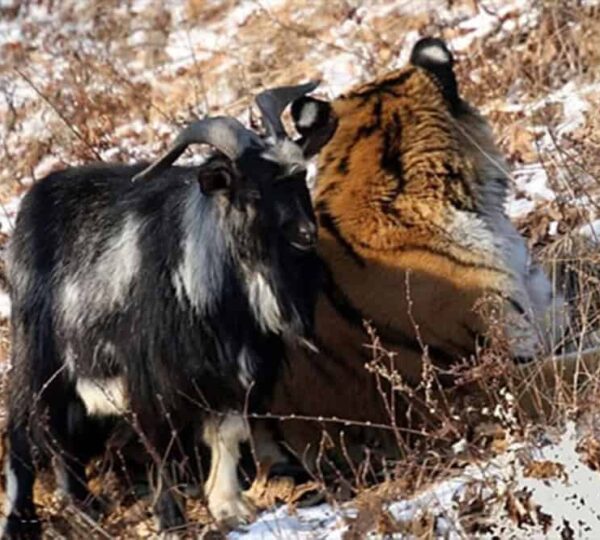From Predator to Companion: The Unexpected Friendship of Amur and Timur
At Primorye Safari Park, located in Russia’s remote Far East, an extraordinary and heartwarming story began to unfold—one that defied the basic laws of nature and captured the attention of people worldwide. This incredible tale centers around two unlikely companions: a goat named Timur and a powerful Siberian tiger named Amur. The situation was, by all accounts, precarious. Timur, a small and vulnerable goat, was placed deliberately into Amur’s enclosure. Amur, a massive predator with years of experience hunting and surviving in the wild, was naturally expected to see Timur as nothing more than prey.
The odds were stacked against the goat from the very beginning. However, what transpired in the following days confounded everyone involved. Instead of attacking or chasing Timur away, Amur took a surprising and compassionate approach—he chose not to harm the goat. Even more astonishingly, Amur appeared to accept Timur as a part of his environment. The caretakers at the park watched in amazement as the tiger and goat began sharing space peacefully, behaving more like close companions than predator and prey.
Day after day, the two animals were seen walking side by side, resting in the same sunlit patches of the enclosure, and engaging in playful behavior that was both tender and unexpected. Timur displayed an extraordinary lack of fear around Amur, even venturing close enough to nudge the tiger playfully or claim his favorite resting spot without any sign of distress. Amur, for his part, tolerated these bold gestures with patience, sometimes responding with gentle movements that suggested a bond had been formed between them. It was as if the natural order had been momentarily rewritten right before the caretakers’ eyes.

Over the weeks, the relationship between Amur and Timur deepened. Timur loyally followed Amur’s lead, while the tiger appeared to embrace the goat’s presence, no longer viewing him as a potential meal but rather as a companion worthy of protection. This unexpected friendship puzzled the park staff, many of whom had initially braced themselves for the inevitable—Amur’s predatory instincts taking over. One caretaker remarked, “It was as though Amur consciously decided that Timur was not prey. He chose friendship instead.” This sentiment captured the essence of what everyone was witnessing: a powerful, living example of empathy and connection transcending instinct.
News of this unique friendship quickly spread beyond the confines of Primorye Safari Park. Visitors flocked to see the tiger and the goat together, eager to witness this rare phenomenon firsthand. Photographs and videos circulated widely on social media platforms, enchanting people around the globe and sparking conversations about the complexities of animal behavior. The story resonated with many because it symbolized something deeply hopeful: that even creatures defined by a natural hierarchy of hunter and hunted could find common ground and coexist peacefully.

The relationship between Amur and Timur was more than just an unusual animal companionship—it became a symbol of trust, resilience, and the possibility of harmony in the face of difference. A tiger, whose survival in the wild depends on its role as a predator, choosing to nurture rather than harm a goat, challenged long-held assumptions about nature and survival. This bond reminded observers that sometimes, empathy and understanding can override even the strongest primal instincts.
Caretakers remained vigilant, aware that the fragile peace could be disrupted at any moment by the natural behaviors embedded in Amur’s instincts. They carefully monitored the animals, ensuring that neither was in danger. Despite this caution, the friendship continued to blossom for weeks, providing a powerful lesson about the potential for kindness and connection in even the most unlikely circumstances.
Ultimately, the story of Amur and Timur serves as a remarkable reminder that the natural world is filled with surprises—moments where the expected gives way to the extraordinary. Here, in a quiet corner of a Russian safari park, a tiger and a goat—traditionally seen as predator and prey—walked side by side, embodying a profound message of coexistence. Their story touched hearts, inspired awe, and offered hope that sometimes, the strongest and most meaningful friendships are those that were never supposed to exist.
In a world often divided by differences and conflicts, the friendship between Amur and Timur encourages us to look beyond instinct and expectation, to embrace compassion, and to believe in the transformative power of unlikely bonds.
People Are Just Realizing Why Women’s Underwear Have A Bow On Front


Underpants. You wear them almost every day of your life, but you probably don’t give them or their peculiarities a lot of thought.
For example, in 2021, we saw that some of you were unaware of the purpose of the holes in front of boxer shorts… We’ve since learned that some individuals find women’s underwear mysterious, especially the tiny bow that occasionally adorns it.
Although the bow is undoubtedly ornamental, there is a story that has circulated on the Internet over the years suggesting that this wasn’t always the case.
“Now? Because it’s cute, it’s feminine, it evokes innocence, and it makes it really easy to tell which side is the front when dressing hastily in the dark,”
“What about the tradition’s origins? It dates back to the time when elastic bands were used, when your pants were fastened with a ribbon that was inserted through the eyelet lace on top. You knotted the ribbon in the little bow, which is conveniently located in the front where it’s most convenient to execute such an operation.”

Although the idea is tenable—people preferred wearing underwear before elastic was created in 1820 and became widely used in apparel in the 1900s—there isn’t much proof shown to support the assertion.
In the medieval centuries, men undoubtedly wore loose drawers, or “braies,” that were fastened with a drawstring or a belt. But we no longer tie a belt around our underwear to honor the tradition, nor do men’s underwear still feature bows.
What women in Europe wore prior to the fifteenth century is a subject of some debate. It is a lot to expect of an underpant that writing, art, and textiles that have been sufficiently conserved to endure to this day provide the majority of our evidence. After then, women wore corsets occasionally along with petticoats and nightie-like clothing underneath their attire, known as chemises. Historian Tim Lambert of Local Histories claims that they also wore drawers in the 1800s. At first, they were simple, but as the century went on, they became increasingly ornate, covered in bands and lace.
Women, girls, and young boys all wore pants, which first appeared in France in the 19th century. We refer to these baggy, long pants—which are actually just one item—as a “pair of underpants”
Conversely, it’s possible that underwear producers just found it to be a charming, ornamental touch, unrelated to historical customs. Who doesn’t appreciate a bow, after all?
Foreigner robbed gold shop in Da Nang arrested









